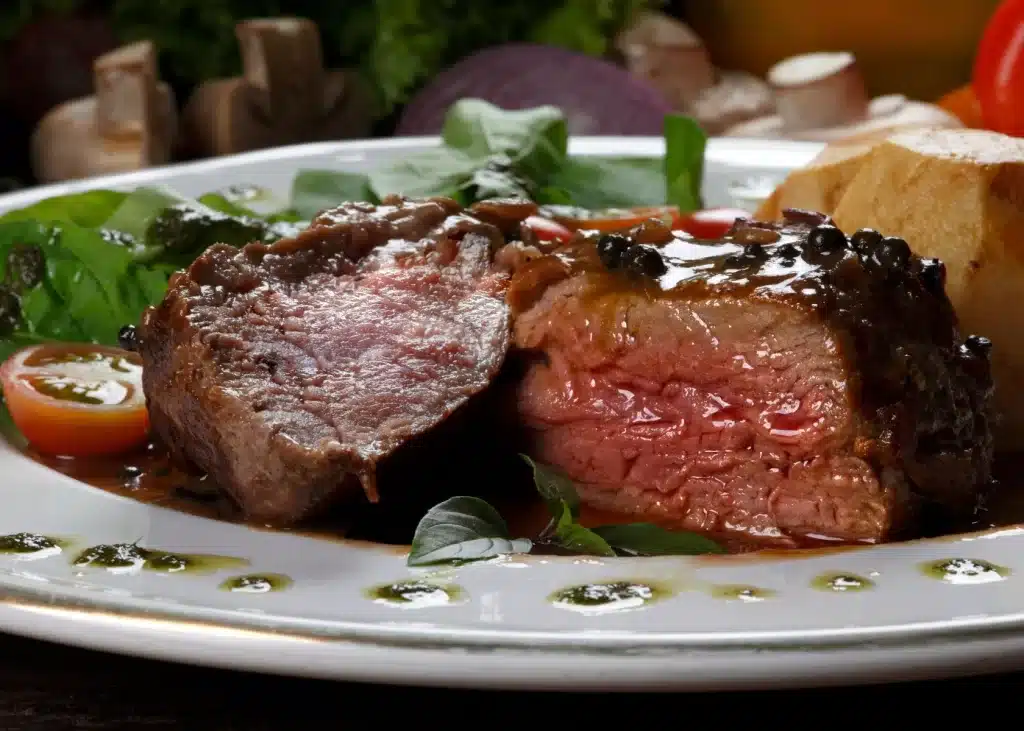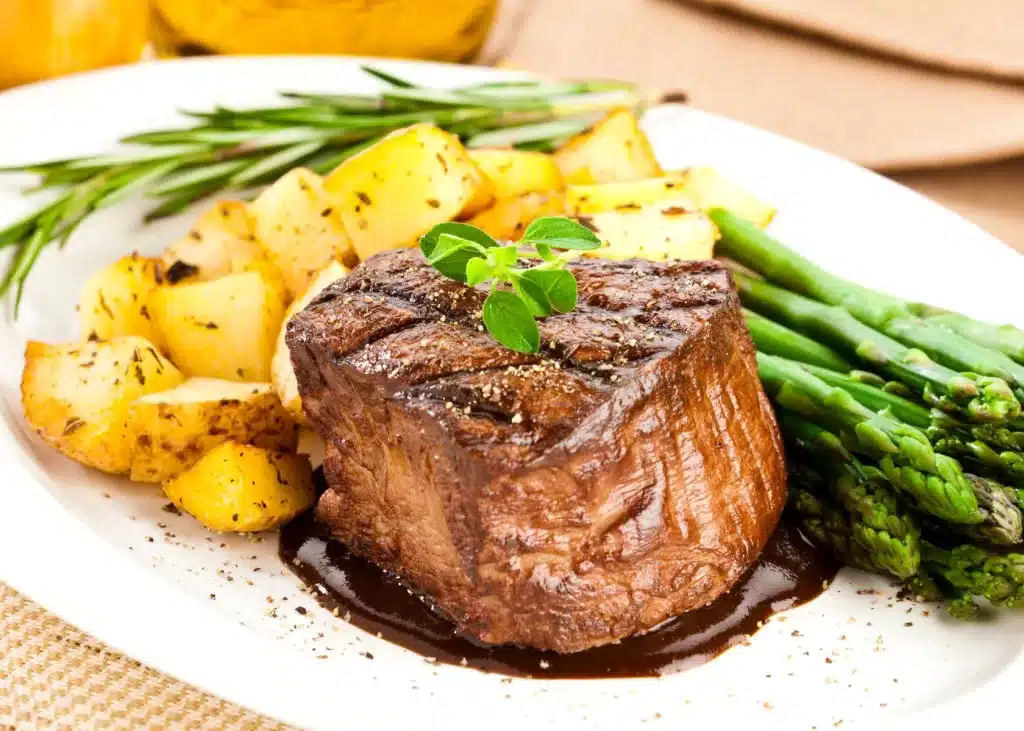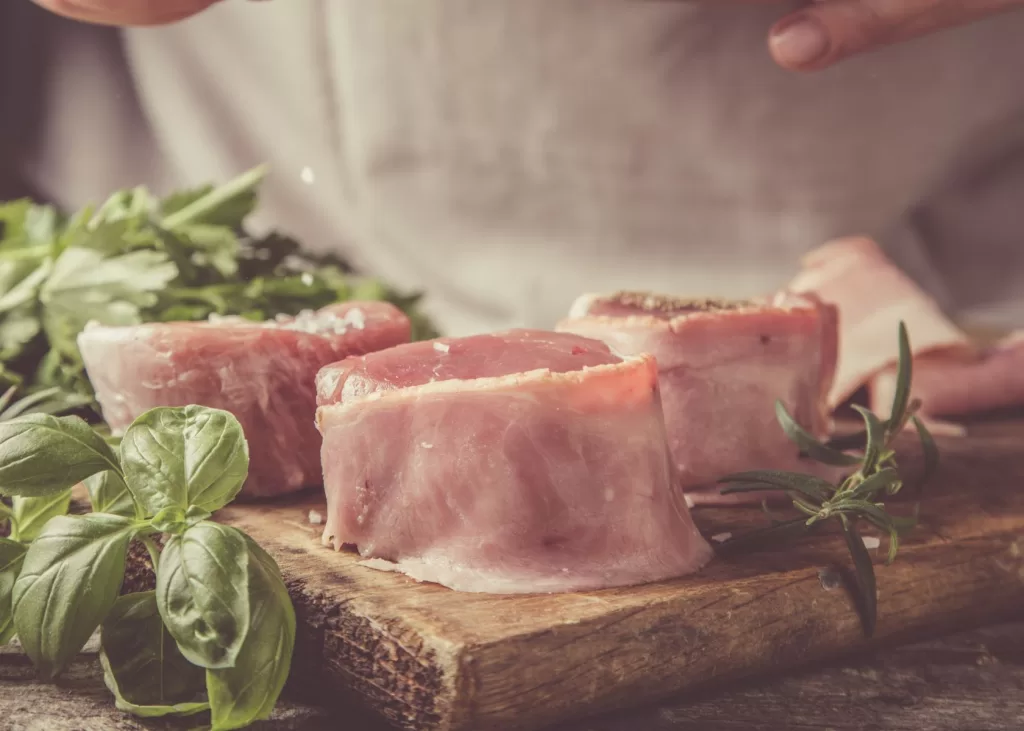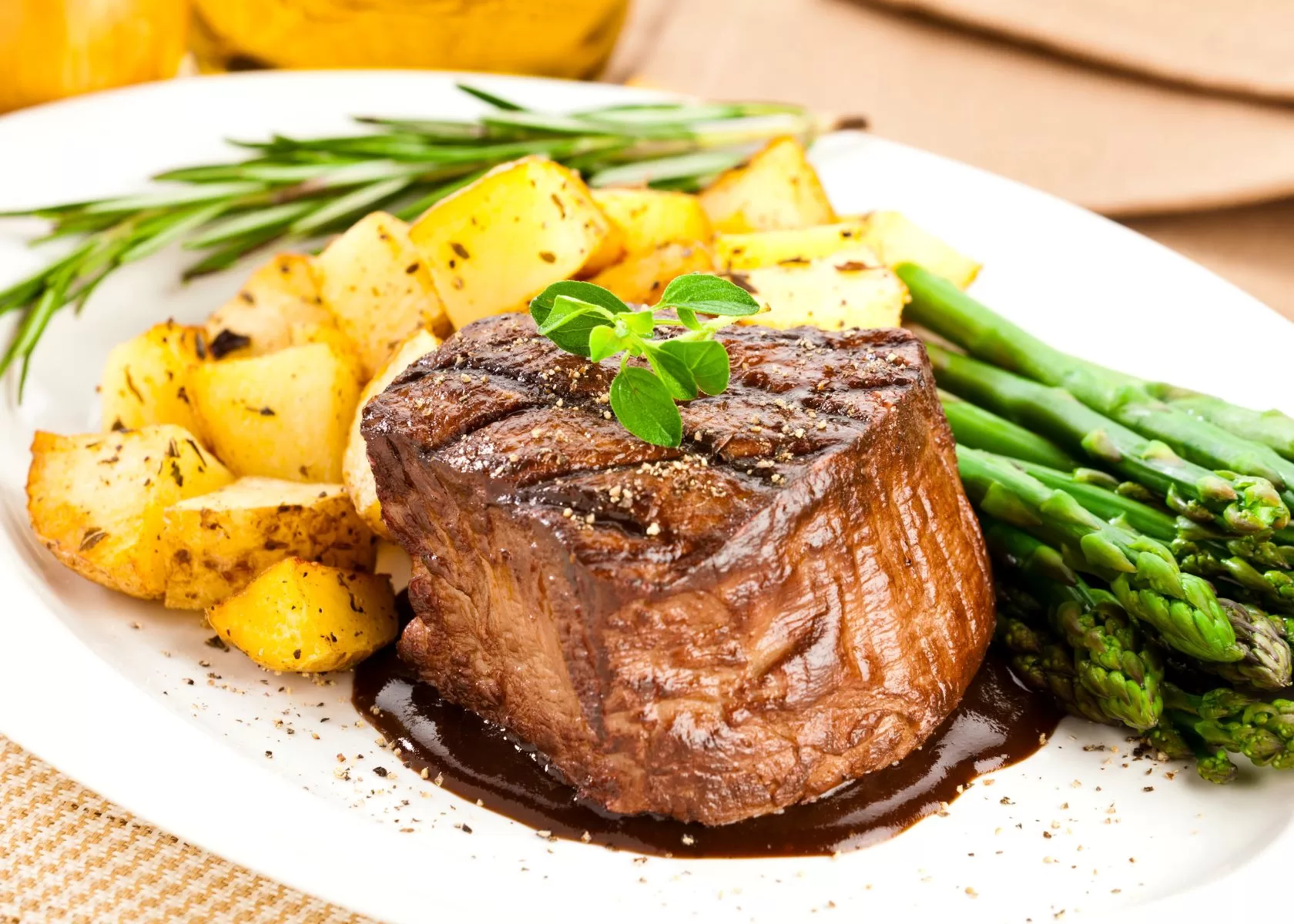Filet mignon is considered one of the most desirable and tender cuts of beef. Its tenderness can be attributed to its small size and lack of fat marbling. This premium cut comes from the tenderloin, which runs along the cow’s spine. In this article, we will look at how to cook filet mignon in a pan.
While filet mignon is often prepared in restaurants, it can also be made at home for restaurant quality. One of the easiest ways to prepare tender, juicy filet mignon is to pan-sear it in a hot skillet. With just a few ingredients and a heavy pan, you can enjoy the perfect filet mignon without needing a grill or extensive cooking experience.
Ingredients
Cooking filet mignon in a pan only requires a few simple ingredients:
- Filet mignon steaks
Choose the number of filets based on how many people you are serving. For pan searing, aim for steaks about 1 1⁄2 – 2 inches thick so they can develop a nice sear on the outside while cooking to the desired doneness inside. You can tie together two thinner steaks if thicker cuts are unavailable. Purchase the best quality filet mignon, preferably Prime or choice-grade beef. - Butter or oil
Use butter or a high smoke point neutral oil like avocado, grapeseed, or canola oil to coat the pan. Butter provides delicious flavor, while oil allows cooking at higher temperatures. - Salt and freshly ground black pepper
Salt brings out the flavors of beef and adds a tasty crust when seared. Coarse kosher or sea salt works best. Always use freshly cracked pepper for the most aroma and flavor. - Aromatics like garlic, thyme, rosemary (optional)
Minced garlic, thyme, and rosemary complement filet mignon nicely. Make an easy compound butter by mixing soft butter with minced garlic and chopped fresh herbs.
Equipment

Pan searing filet mignon doesn’t require too much specialty equipment. Here’s what you need for how to cook filet mignon in a pan:
- Heavy skillet or frying pan, preferably cast iron or stainless steel
Choose a pan that can withstand very high heat, such as cast iron or stainless steel, with an aluminum or copper core. The heavy pan should keep steady heat for proper searing. Use a 10 to 12-inch pan for cooking 2 steaks. - Instant-read thermometer
A thermometer takes the guesswork out of determining steak doneness. It provides an accurate reading of the internal temperature so you achieve your preferred degree of doneness. - Sturdy spatula
Use a strong metal spatula to flip the steaks easily. A sharp spatula helps prevent the tearing of the meat. - Rimmed baking sheet or plate
Remove cooked steaks to a baking sheet or plate. The rim catches any juices that run off. - Aluminum foil
Lightly tent foil over steaks as they rest to retain heat.
Before Cooking
Follow these tips before cooking your filet mignon for best results:
Selecting Filet Mignon
When choosing filet mignon at the grocery store or butcher shop, look for beef that is bright red rather than brown or gray. Seek steaks with bright white fat versus yellow fat, indicating age. For improved tenderness, opt for USDA Prime over Choice grade beef if the budget allows.
Plan on purchasing 8-12 ounces of filet mignon per person. Filets should be 1 1⁄2 – 2 inches thick for proper pan searing and should not be cold from the fridge, which inhibits browning.
Removing Steak from the Fridge
It is important to remove steaks from the refrigerator at least 30-45 minutes before cooking. This lets them lose their chill and come closer to room temperature. Meat that goes straight from the fridge into the hot pan will sear unevenly and likely be overcooked externally before reaching the desired internal temperature.
The warmer meat sears better since it doesn’t lower the pan temperature as dramatically once added. Letting it sit also helps the steak cook more evenly, giving you superior results.
Patting the Steak Dry
Be sure to pat your filets very dry with paper towels just before cooking. Any excess moisture on the exterior causes steam when the meat hits the hot pan. That steam makes getting a nice brown sear almost impossible. The paper towels absorb surface moisture, so you’re left with the steak’s proteins ready to caramelize and sear perfectly.
Season Generously with Salt and Pepper
Just before cooking, liberally season both sides of the steaks with coarse kosher salt and freshly cracked peppercorns. Sprinkle the salt so it fully coats the entire surface. Cracked pepper should also be applied somewhat heavily so you get a spice aroma and flavor in every bite.
Crushed pepper brings out extra beefiness from the meat when cooked. If using compound butter or herb paste, coat each steak on both sides, so flavors can penetrate before hitting the heat. Let the seasoned steaks stand at room temperature as the pan heats up.
Prepare Pan Sauce Ingredients
If making a quick pan sauce from the flavorful steak drippings, prep any ingredients like minced shallots, garlic, rosemary, thyme, and parsley. Measure out broth or stock and have wine or vinegar handy for deglazing. Whisk in a few tablespoons of cold butter once the sauce is done to enrich it with a smooth, silky texture.
Cooking Filet Mignon in a Pan

Pan searing is one of the best techniques for cooking filet mignon since the short cooking time at high heat gives you an incredibly tender interior with a beautifully browned and crispy crust. Follow these steps for foolproof results on how to cook filet mignon in a pan:
Getting the Pan Very Hot
Using very high heat to achieve a good sear on filet mignon is crucial. Heat the dry skillet or pan over maximum heat until it just starts to smoke. The smoking indicates the pan has reached the ideal temperature of around 500°F for properly browning and searing the steak. If needed, give the pan extra time to preheat so it gets rip-roaring hot.
Adding the Fat
Once the pan starts smoking, carefully add just enough butter or oil to lightly coat the bottom of the surface. Hot oil will shimmer, and loose butter will instantly sizzle and foam. Tilt and turn the pan to distribute evenly over the entire cooking surface. There should be just a light sheen of fat. Too much will inhibit proper searing.
Placing the Steaks in the Pan
Gently lay the steaks in the pan, leaving some space between them if cooking more than one. Do not move the steaks immediately, or they will stick badly. Allow the steaks to sear undisturbed so a flavorful, brown crust develops on the side against the pan.
Resist poking at them! Letting that first side brown well before attempting to turn or flip is key for ultimate flavor and texture. Listen for an audible sear as the proteins and sugars in the meat caramelize.
Lower the Heat if Pan Smoking Too Heavily
If your pan is so hot that heavy smoke rises continuously around the meat, lower the temperature slightly. Some smoke is expected and desirable, but too much smoke plus scorching heat leads to a burnt exterior and dried-out filet mignon. Keep a close watch and reduce the stovetop temperature if the meat seems to be cooking too quickly or if the smoke is overwhelming.
Flip and Sear Second Side
After 2-4 minutes, allow one edge of the meat to lift and peek at the color underneath. You want a deep, amber-brown crust on the first side before flipping. Use the metal spatula to carefully lift and support the meat, and flip it over to expose the nicely browned exterior.
Repeat the searing process on the second side for another 2-4 minutes, watching for excess smoking or charring and lowering heat as needed. Press gently with the spatula as the second side finishes cooking to encourage maximum browning.
Cook Filets to Desired Doneness
Some carryover cooking happens after the meat leaves the pan, so always remove filet mignon from the stove when it’s 5-10°F cooler than your target temperature for your preferred doneness level.
Use an instant-read thermometer inserted horizontally into the thickest portion of the steak to gauge when to take it off the heat. When checking, lift the meat enough that the probe isn’t touching metal, which would provide an incorrect temperature reading.
If you enjoy medium rare steak, pull it from the pan once it reaches an internal temperature of 125-130°F. Then, let it rest to allow the temperature to climb another 5 degrees as it sits.
For rare steak, remove from heat around 115°F. For true medium doneness, take it up to 135°F, and well-done filet mignon should hit at least 150°F internally before taking off the heat.
Make Simple Pan Sauce (Optional)
To make an easy pan sauce, remove steaks from a plate and cover them loosely with foil. Set aside and keep warm. Add minced shallots, garlic, and any herb sprigs to the still-hot pan. Sauté briefly until fragrant. Deglaze the pan with 1⁄2 cup wine, stock, or broth, stirring and scraping up browned bits stuck on the bottom.
Continue cooking the liquid over medium-high heat for several minutes to reduce slightly. Off heat, remove herb stems, and whisk in several tablespoons of cold butter. The butter should thicken the sauce nicely.
Taste and season with salt and pepper if needed. You can also stir in a splash of vinegar or lemon juice at the end for brightness. Serve sauce drizzled over the rested steaks.
Determining Doneness

Cooking filet mignon properly relies heavily on removing it from the heat at the right moment to achieve your ideal doneness. Here are guidelines on how to cook filet mignon in a pan at each stage of doneness:
Rare
The center of the steak will be bright red and cool, around 115-125°F on a meat thermometer. Rare filet mignon takes the least time to cook. A 1-inch thick rare steak may only need 4-6 minutes total sear time (2-3 minutes per side in a hot skillet).
Medium Rare
A medium rare filet will have a warm, deep red center registering 125-135°F. It may take 6-8 minutes to pan-sear a 1-inch cut to medium-rare doneness. Many steak enthusiasts prefer medium rare filet mignon for flavor and tenderness.
Medium
The middle of a medium steak will be light pink, losing some redness and reaching 135-145°F internally after cooking. Expect closer to 8-10 minutes of cooking time for a 1-inch filet cooked to medium.
Medium Well
Medium well filet mignon has a thin line of pinkness in the center and reads 140-150°F on a meat thermometer after resting. Plan on 10-12 minutes for a 1-inch filet cooked to medium well.
Well Done
A well-done filet mignon lacks any hint of pinkness, and the interior temperature exceeds 150°F after resting. It can take 12 minutes or longer to cook a thinner 1-inch cut to be well done. The extra cooking time requires very careful watching to prevent a dried-out steak.
In addition to internal temperature, check doneness by cutting into the thickest part of the meat to view the color inside. Pressing the filet mignon with tongs or a spatula will give you visual feedback. Rare steaks feel pretty soft. Medium rare and above will bounce back slightly. Filet mignon overcooked beyond medium well with an almost brittle texture when pressed.
Observe the juices running from the resting meat as well. Rare steak juices will be deep red, while medium-rare lets off a reddish pink tint. Well-done meat gives off clear juices.
Letting Filet Mignon Rest
Allowing your filets to rest sufficiently after cooking and before cutting is one of the most important steps. There is carryover cooking that continues gently raising the internal temperature 5-10 degrees once removed pan. Resting also gives time for the proteins in the meat to relax and reabsorb some free-flowing juices.
This evenly redistributes moisture through the steak instead of it all running out when you slice it right away. A bare minimum of 5 minutes rest is recommended, but ideally, give pan-seared filets 8-10 minutes to relax before serving.
Resting Guidelines
- Transfer steaks immediately from the hot pan to a rimmed baking sheet or plate. Avoid putting directly on a cutting board since juices will pool underneath instead of on the platter to spoon back over the meat later.
- Lightly, loosely tent aluminum foil over the tops of the steaks while they rest to retain warmth. Take care not to crimp the foil tightly onto the meat, which would trap steam and moisture. Allow some airflow so the exterior doesn’t start steaming.
- Resist repeatedly peeking under the foil as the rest! Every time cool air meets hot meat, it stops it from retaining warmth effectively. Opening prematurely also doesn’t allow juices time to settle back into the steak before carving.
- Top steaks with a generous pat of herb butter for improved flavor and tenderness, letting it melt slowly over the meat as it rests. Any pan sauce can be spooned over the rested steaks right before serving. Drizzling with good olive oil and sprinkling with flaky sea salt also makes for tasty resting.
Slicing and Serving Pan Seared Filet Mignon

Follow these last tips for presenting perfect, mouthwateringly tender filet mignon straight from the pan:
- Just before slicing, season rested steaks on both sides with flaky sea salt and freshly cracked black pepper to taste.
- For improved tenderness, always slice filet mignon against the grain of the meat fibers on the bias if the cut allows. Cut across the direction of the muscle lines rather than parallel to them.
- For a steak thicker than one inch, consider slicing it on an angle into slightly thinner strips rather than one thick hunk. This increases the amount of browned exterior pieces with each slice compared to one giant cross-section of the whole filet. It also exposes more interior meat to any resting pan sauce and juices.
- For ultimate richness, top filet mignon servings with a spoonful of pan sauce, pat of herb compound butter and/or a drizzle of great olive oil letting them melt down into the hot meat.
Side Dishes for Pan Seared Filet Mignon
Filet mignon deserves some tasty company on the plate. Consider serving your perfectly pan-seared steaks with:
- Herb roasted baby potatoes
- Sautéed mushrooms or onions
- Steamed or roasted asparagus
- Creamed spinach or roasted Brussels sprouts
- Green salad with vinaigrette
Hearty reds like Cabernet, Zinfandel or Malbec make excellent pairings for seared filet mignon. For an extra decadent finish to the meal, serve profiteroles or créme brûlée for dessert!
Troubleshooting on How to Cook Filet Mignon in a Pan
Turn out beautifully cooked filet mignon from a hot pan by avoiding these common mistakes:
Steak Lacks Browned Crust
Ensure your pan and fat are very hot before adding steaks so they sear rather than steam. Let the first side brown well before attempting to flip steaks. Use heavy pan that maintains heat.
Tough, Chewy Meat
Always slice filet mignon thinly against the grain after resting to prevent chewiness. Don’t cook steaks beyond medium or risk drying out the lean tenderloin cuts.
No Flavor
Generously season meat before and after cooking. Sprinkle with coarse salt and pepper. Top with compound butter, herbs, and pan sauce for maximum flavor.
Burnt Outside, Undercooked Inside
Use thick cuts of at least 1 – 1 1⁄2 inches and watch heat closely, lowering temperature setting if smoke overwhelms. Rely on a meat thermometer for perfectly cooked interiors every time.
Overcooked All The Way Through
Pull steaks from stove just below final target temp to allow carryover cooking to finish without overshooting doneness. Tent meat while resting so it stays warm instead of overcooking. Slice thinly if meat ends up beyond desired doneness.
Conclusion
- Use very high heat and minimal oil/butter to achieve excellent sear
- Let steaks brown well on the first side before only flipping once
- Lower heat if smoking heavily and watch closely to prevent charring
- Cook to 5° below target internal temp and allow carryover cooking to finish while resting
- Rest meat for at least 5 minutes, tented loosely in foil before slicing thinly against the grain
In around 15 minutes start to finish, you can enjoy salon-quality filet mignon easily pan-seared right in your own kitchen. Mastering the quick, hot pan sear method truly does yield tender, juicy and flavorful results on par with the best steakhouses. Serve sliced filet mignon napped in a simple pan sauce and you may find it hard to ever order filet out again!

